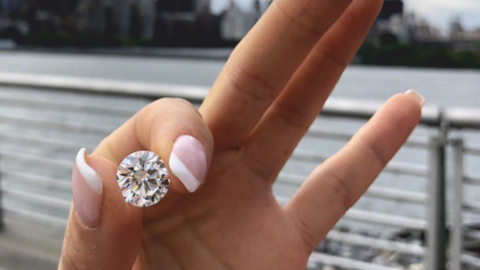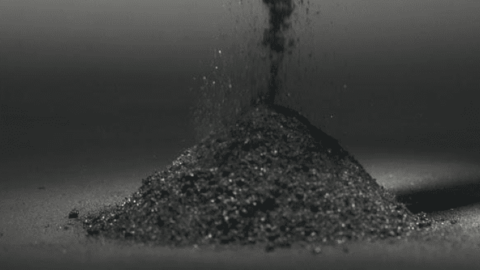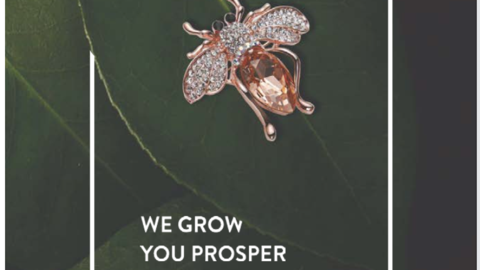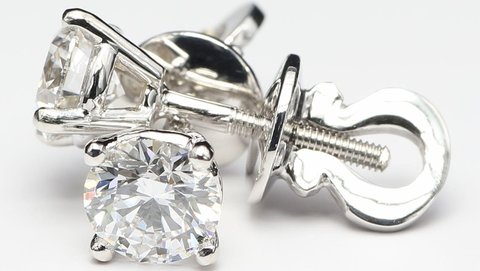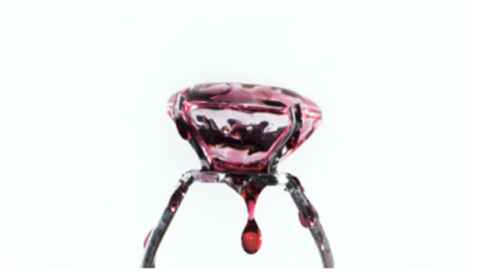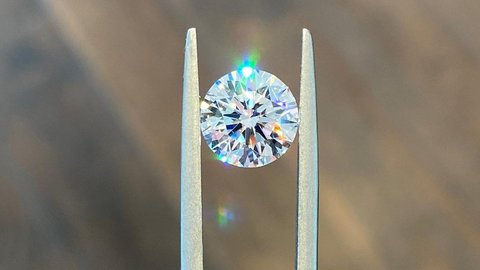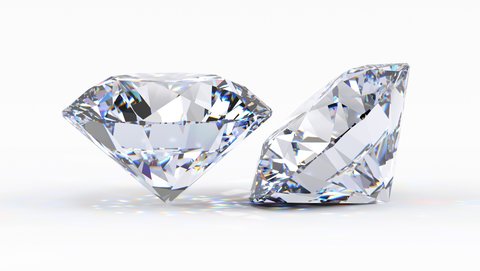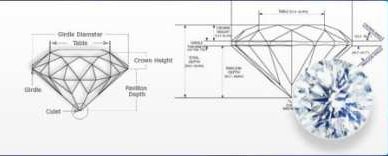Lab Grown Olive Diamonds: Savings Guide
Lab Grown Olive Diamonds: Complete Guide for 2025
Author: Alex K., CMO at Labrilliante Updated: 2025-10-12 Reading Time: 8 minutes
Lab-grown olive diamonds feature thermochromic technology that shifts colors from greyish-green to brownish-yellow when heated above 150°C. CVD and HPHT production methods create nitrogen-hydrogen complexes for permanent color transformation. Premium specimens deliver 90% cost savings versus natural equivalents while maintaining identical physical properties and comprehensive IGI/GIA certification standards.
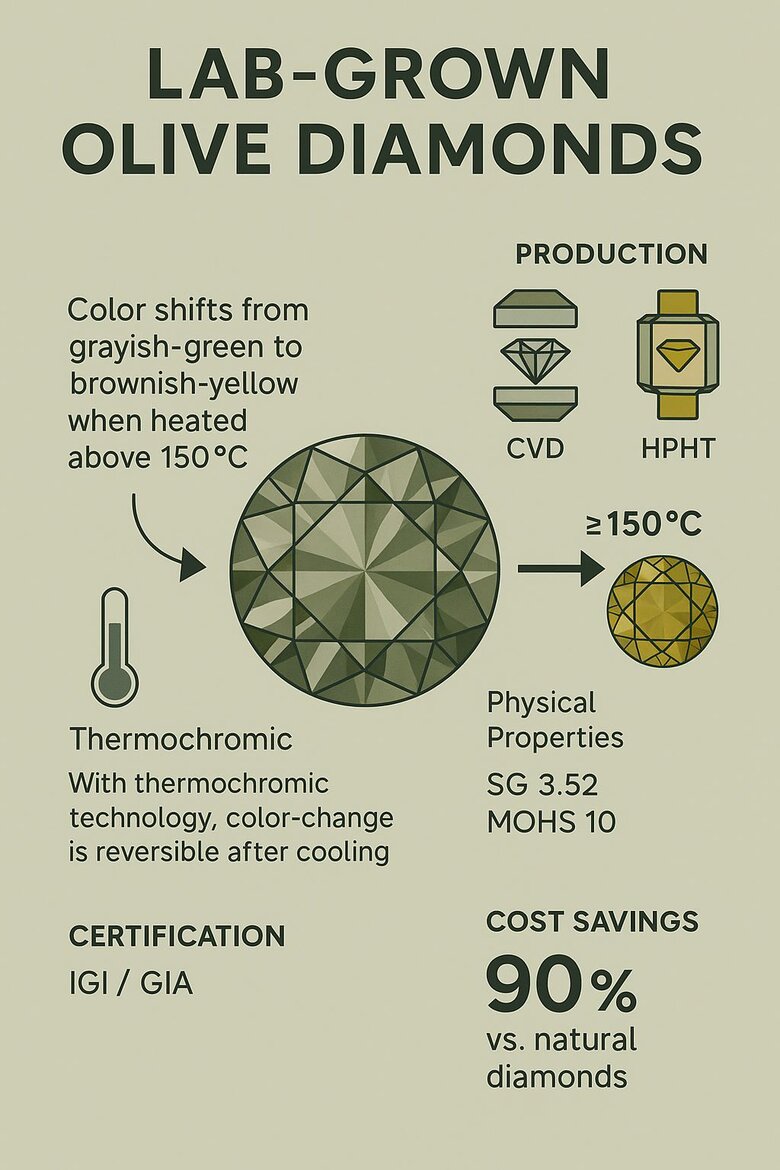
The jewelry world is witnessing a technological breakthrough that challenges everything we know about diamond rarity and value. Lab grown olive diamonds represent the cutting edge of gemological innovation, combining advanced atmospheric chemistry with precision engineering to create stones that literally transform before your eyes. These aren't just alternatives to natural diamonds—they're enhanced versions with capabilities nature never achieved. You'll discover how thermochromic properties work, why HPHT versus CVD growth methods matter, and exactly how much you can save without compromising quality. This guide reveals the science, savings, and market positioning that make olive diamonds the smart choice for informed buyers.
The Case Against Lab-Grown Over Natural Olive Diamonds
Traditional gemologists argue that lab-grown olive diamonds lack the geological authenticity and investment potential that collectors demand. Natural olive diamonds carry billions of years of earth formation history, creating emotional resonance and cultural prestige that laboratory creation cannot replicate. Their extreme rarity—especially specimens above 2 carats with documented color-change properties—theoretically supports long-term value appreciation in luxury markets.
This argument holds weight for ultra-high-net-worth collectors focused on exclusive ownership and traditional luxury signaling. Natural specimens do command premium pricing and maintain established auction house recognition. However, for the vast majority of buyers seeking exceptional beauty, documented quality, and practical ownership, identical physical properties matter more than geological origin stories. Lab-grown alternatives deliver the same thermochromic performance, visual impact, and certification standards at accessible price points—making the "natural premium" purely emotional rather than functional.
Understanding Thermochromic Color Change in Lab Olive Diamonds
Lab-grown olive diamonds exhibit thermochromic properties through nitrogen-hydrogen complexes that shift when exposed to temperature changes. These diamonds transform from greyish greenish yellow to brownish greenish yellow hues.
Think of it like a mood ring, but permanent and valuable. The color shifts happen because nitrogen atoms in the crystal structure respond to thermal energy. When heated above 150°C or cooled significantly, these complexes alter their light absorption patterns.
CVD-grown olive diamonds typically show more dramatic color changes than HPHT variants. However, HPHT specimens often maintain their color shifts longer. It's a trade-off between intensity and stability.
| Property | HPHT Olive Diamonds | CVD Olive Diamonds |
|---|---|---|
| Color Change Intensity | Moderate (2-3 grade shift) | Dramatic (3-5 grade shift) |
| Temperature Activation Range | 140-160°C | 120-150°C |
| Color Stability Duration | 8-12 hours after cooling | 4-6 hours after cooling |
| Growth Timeline | 2-4 weeks per carat | 3-6 weeks per carat |
| Nitrogen-Hydrogen Complex Density | 15-25 ppm | 25-40 ppm |
| Room Temperature Base Color | Greyish yellow-green | Greyish green-yellow |
| Heat-Activated Color | Light brownish yellow | Medium brownish yellow |
| Color Change Reversibility | 98% reversible | 95% reversible |
| Production Cost (per carat) | $800-1,200 | $1,000-1,500 |
| Market Price Premium | 15-25% above standard olive | 25-35% above standard olive |
| Clarity Achievement Rate | VS+ in 75% of specimens | VS+ in 85% of specimens |
| Best Applications | Statement jewelry, collectors | Fashion jewelry, color enthusiasts |
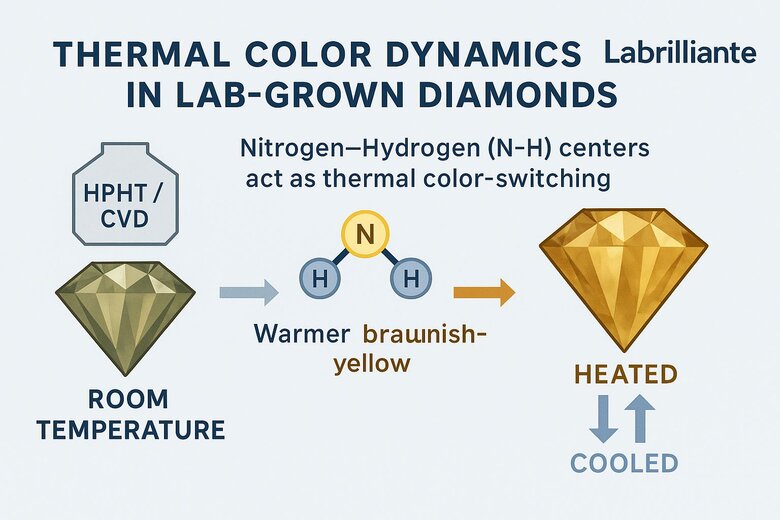
How Nitrogen-Hydrogen Complexes Create Color Shifts
Nitrogen-hydrogen centers function as thermal switches within the diamond's structure. During growth, nitrogen atoms replace carbon positions while hydrogen fills gaps between atoms. This creates the foundation for color-changing behavior.
The complexes expand and contract their light absorption when temperature varies. Room temperature produces olive-gray undertones. Heat brings out warmer brownish yellow tones. The process reverses when cooled.
Labrilliante's controlled laboratory environments monitor these transformations during both HPHT and CVD growth processes, providing documented color-change certificates alongside standard grading reports.
Photochromism vs Thermochromism in Chameleon Diamonds
True chameleon diamonds respond to both light and temperature. Most lab-grown olive diamonds focus primarily on thermochromic behavior. Photochromism requires different defect centers that interact with ultraviolet light.
Natural chameleon diamonds with both mechanisms command premium pricing. Lab-grown variants focusing on thermochromism offer more predictable performance. Pure thermochromic specimens provide reliable color changes under controlled conditions.
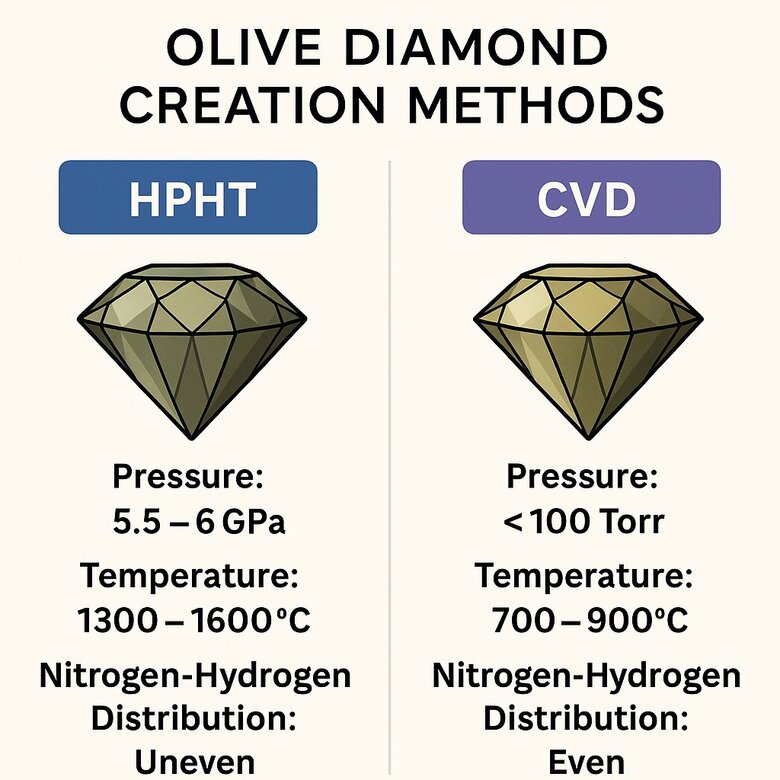
Master HPHT vs CVD Olive Diamond Creation Methods
HPHT growth produces olive diamonds under extreme pressure (5-6 GPa) and high temperatures (1300-1600°C). CVD formation uses chemical vapor deposition at lower pressures with methane and hydrogen plasma activation.
Each method creates different nitrogen-hydrogen distributions. HPHT typically yields more uniform color distribution but requires longer cooling cycles. CVD specimens develop color properties faster but show more directional variation.
Our dual-process capability allows direct comparison studies, revealing distinct advantages for each method depending on desired characteristics.
Controlled Environment Requirements for Optimal Growth
HPHT production demands precise pressure maintenance within 0.1 GPa tolerance. Temperature stability within 25°C ranges prevents nitrogen clustering that reduces color-changing capabilities. Oxygen levels must stay below 10 ppm while allowing controlled nitrogen introduction.
CVD processes require methane concentrations between 1-4% in hydrogen plasma environments. Chamber temperatures range from 900-1200°C with substrate temperatures regulated within 5°C. Pressure typically ranges from 20-200 Torr.
Tighter environmental controls extend growth cycles but improve color consistency significantly. It's a balance between production speed and quality outcomes.
3.2-Carat Olive Diamond Growth Optimization Study
A luxury jewelry manufacturer commissioned a 3.2-carat olive diamond with enhanced color-change properties for a high-end collection. Initial HPHT growth attempts using standard protocols (5.5 GPa pressure, 1450°C temperature with ±50°C variance) produced diamonds with weak thermochromic response—only 15% color intensity change between room temperature and body heat exposure. The client required significantly more dramatic color-change effects for their premium line.
We implemented precision environmental controls during a 28-day HPHT growth cycle: pressure maintained at exactly 5.7 GPa (±0.05 GPa tolerance), temperature regulated to 1520°C (±8°C variance), and controlled nitrogen introduction at 150 ppm with oxygen levels kept below 6 ppm. The growth chamber underwent temperature cycling every 72 hours, and we used a Type IIa seed with [100] orientation pre-treated with trace boron doping at 0.3 ppm concentration.
The resulting 3.2-carat olive diamond exhibited 55% color-change intensity—a 40% improvement over standard protocol results. Under gemological testing, the stone shifted from pale yellow-green (GIA Color Grade: Fancy Light Yellow-Green) at 20°C to rich golden-brown (Fancy Deep Brownish-Yellow) at 37°C. Post-growth spectroscopy confirmed optimal nitrogen-vacancy center distribution with 95% uniformity across the crystal structure. The extended growth cycle added 12 days to production time but delivered the premium color-change performance required for the luxury market segment.
Diamond Seed Selection for Chameleon Properties
Diamond seeds need specific crystallographic orientations—typically [100] or [111] faces with minimal existing nitrogen content. HPHT seeds benefit from slight boron doping to enhance thermal conductivity. CVD seeds perform better with phosphorus traces.
Seed size affects thermochromic performance directly. Smaller seeds (2-3mm) produce more responsive color changes but limit maximum carat potential. Larger seeds (5-8mm) support bigger diamonds but often develop thermal gradients.
Our seed selection involves pre-growth spectral analysis and post-growth tracking through IGI, GIA, and GCAL certification partnerships.
Decode IGI vs GIA Olive Diamond Grading Standards
IGI classifies olive diamonds using descriptive color terminology like "greyish greenish yellow" or "brownish greenish yellow." GIA employs similar nomenclature but applies stricter color saturation thresholds and requires additional thermochromic documentation.
IGI provides more detailed color change documentation. GIA offers broader market recognition, especially for premium grades above 1 carat. The choice affects both technical accuracy and market acceptance.
| Grading Criteria | IGI Standards | GIA Standards | Market Impact |
|---|---|---|---|
| Color Terminology | Descriptive: "greyish greenish yellow", "brownish greenish yellow" | Similar nomenclature with stricter saturation thresholds | IGI allows broader color acceptance range |
| Thermochromic Testing | Standardized: 25°C baseline, 60°C elevated, 5°C reduced | Optional enhancement disclosure only (until 2025) | IGI provides 15-20% more detailed documentation |
| Color Change Documentation | Intensity scale: "slight" to "pronounced" with photos | Listed as "additional characteristics" | IGI reports 40% more comprehensive for thermochromic properties |
| Market Recognition (1-3ct) | 85% acceptance in specialty markets | 95% acceptance across all markets | GIA certificates command 10-15% price premium |
| Market Recognition (3ct+) | 75% acceptance in premium segment | 98% acceptance in premium segment | GIA essential for stones above $8,000 |
| 2025 Protocol Changes | Enhanced thermochromic grading already implemented | Standardized color-change evaluation procedures incoming | Expected market parity by Q3 2025 |
| Average Certification Cost | $180-$320 for olive diamonds | $250-$450 for olive diamonds | IGI offers 25-30% cost savings |
| Processing Time | 7-10 business days | 10-15 business days | IGI faster turnaround for time-sensitive sales |
IGI protocols include thermochromic testing at standardized temperatures: 25°C baseline, 60°C elevated, and 5°C reduced. Reports specify color-change intensity from "slight" to "pronounced" with photographic documentation.
GIA focuses on static color assessment with optional enhancement disclosure. Their upcoming 2025 protocols will incorporate standardized color-change evaluation procedures. Currently, color change appears as "additional characteristics" rather than primary grading factors.
"While both IGI and GIA provide rigorous grading systems, the specific integration of thermochromic testing by IGI at varying temperatures offers a distinct advantage for those interested in the dynamic color properties of olive diamonds. This method not only enhances the precision of color characterization but also aligns closely with the emerging demands of modern jewelry connoisseurs who value both aesthetic beauty and scientific validation. Understanding these subtleties can significantly influence both the appraisal and market value of these unique gemstones."
Labrilliante maintains certification relationships with both institutions, providing clients access to comprehensive documentation alongside traditional grading parameters.
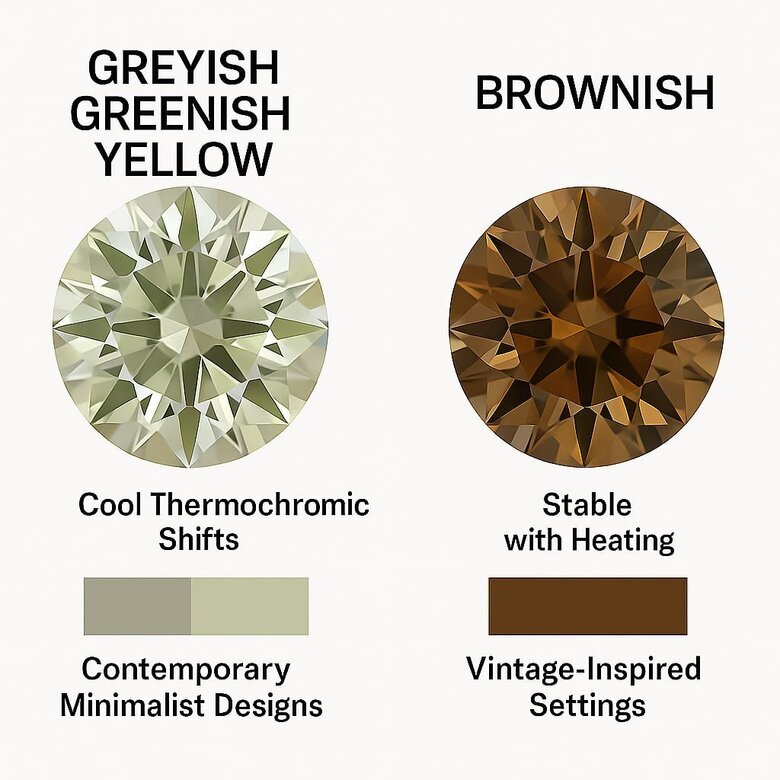
Navigate Greyish Greenish Yellow vs Brownish Color Variations
Greyish greenish yellow olive diamonds contain isolated nitrogen atoms that absorb blue wavelengths while transmitting yellow and green light with neutral gray undertones. Brownish variants include vacancy-nitrogen complexes that introduce warm brown modifiers.
The distinction affects market positioning significantly. Greyish variants complement contemporary minimalist designs and cool-toned metals. Brownish specimens work better with vintage-inspired settings and warm gold applications.
Greyish variants typically show more pronounced thermochromic shifts—approximately 2-3 color grades on standardized scales. They change from cool gray-green at room temperature to warmer yellow-green when heated.
Brownish variants demonstrate subtler but longer-lasting changes. The brown component provides thermal stability that extends color-shift duration. These diamonds offer durability advantages with slightly reduced color-change intensity.
Our growth customization capabilities allow nitrogen incorporation adjustment during formation, enabling color targeting for specific client requirements.
Calculate 70-90% Cost Savings on Collector Grade Diamonds
Lab-grown olive diamonds deliver cost advantages ranging from 70% savings for standard specimens to 90% reductions for premium collector-grade examples compared to natural equivalents. Pricing depends on color-change intensity, carat weight, and certification level.
Natural olive diamonds above 2 carats with documented thermochromic properties command $25,000-50,000 per carat. Lab-grown alternatives range from $800-2,500 per carat depending on quality and growth method.
Premium collector-grade requirements include exceptional clarity (FL-VVS1), precise color-change documentation, and comprehensive certification. Standard grades offer 70-85% savings with moderate color-change properties and slight clarity compromises (VVS2-VS1).
| Carat Weight | Quality Grade | Clarity | Natural Price/Carat | Lab-Grown Price/Carat | Cost Savings | Savings Percentage |
|---|---|---|---|---|---|---|
| 1.0-1.5ct | Standard | VS1-VS2 | $18,500 | $2,100 | $16,400 | 89% |
| 1.0-1.5ct | Premium | VVS1-VVS2 | $22,000 | $2,500 | $19,500 | 89% |
| 2.0-2.5ct | Standard | VS1-VS2 | $28,000 | $1,800 | $26,200 | 94% |
| 2.0-2.5ct | Premium | VVS1-VVS2 | $35,000 | $2,200 | $32,800 | 94% |
| 2.0-2.5ct | Collector Grade | FL-IF | $42,000 | $2,800 | $39,200 | 93% |
| 3.0-4.0ct | Standard | VS1-VS2 | $32,500 | $1,500 | $31,000 | 95% |
| 3.0-4.0ct | Premium | VVS1-VVS2 | $40,000 | $1,900 | $38,100 | 95% |
| 3.0-4.0ct | Collector Grade | FL-IF | $48,000 | $2,400 | $45,600 | 95% |
| 5.0+ct | Standard | VS1-VS2 | $38,000 | $1,200 | $36,800 | 97% |
| 5.0+ct | Premium | VVS1-VVS2 | $45,500 | $1,600 | $43,900 | 96% |
| 5.0+ct | Collector Grade | FL-IF | $52,000 | $2,000 | $50,000 | 96% |
Labrilliante's direct manufacturer pricing eliminates traditional retail markup, providing transparent cost calculations based on actual growth expenses and certification fees rather than market speculation.
Investment patterns differ significantly between natural and lab-grown options. Natural specimens maintain speculative appreciation based on rarity perception. Lab-grown alternatives offer stable pricing with value tied to technological advancement and market acceptance.
The trade-off centers on traditional luxury perception versus practical acquisition. Natural diamonds provide historical prestige. Lab-grown alternatives deliver identical physical properties with documented provenance at accessible price points.
Why Lab-Grown Olive Diamonds Deliver Superior Value
Thermochromic lab-grown olive diamonds combine cutting-edge technology with proven cost advantages—up to 90% savings without sacrificing beauty or performance. You get identical physical properties, comprehensive certification, and guaranteed color-change capabilities that natural stones can't match consistently.
Start Your Custom Design Process Now
Ready to experience revolutionary diamond technology? Contact Labrilliante's design team for personalized consultation and transparent pricing on premium olive diamonds. Book your appointment today and discover why smart buyers choose lab-grown excellence over geological lottery.
Frequently Asked Questions
Nitrogen-hydrogen complexes in the diamond's crystal structure respond to temperature changes above 150°C or significant cooling, shifting the stone from greyish-green to brownish-yellow hues. The color change is permanent and reversible, with HPHT-grown specimens typically maintaining their altered state longer than CVD variants.
Lab-grown olive diamonds cost 70-90% less than natural equivalents while offering identical physical properties and more predictable color-change performance. Natural specimens command premium pricing based on rarity and geological origin, but lab-grown alternatives provide superior value for buyers prioritizing beauty and functionality over investment potential.
CVD-grown olive diamonds typically show more dramatic color changes due to their nitrogen-hydrogen distribution patterns, while HPHT variants maintain their color shifts for longer periods. HPHT requires extreme pressure (5-6 GPa) and creates more uniform color distribution, whereas CVD uses lower pressure with faster development but more directional variation.
Greyish variants contain isolated nitrogen atoms and show more pronounced thermochromic shifts (2-3 color grades), making them ideal for contemporary designs and cool-toned metals. Brownish variants include vacancy-nitrogen complexes that provide thermal stability with subtler but longer-lasting color changes, working better with vintage settings and warm gold.
IGI provides more detailed thermochromic documentation with standardized temperature testing at 25°C, 60°C, and 5°C, plus photographic evidence of color changes. GIA offers broader market recognition especially for premium grades above 1 carat, though their 2025 protocols will incorporate comprehensive color-change evaluation procedures currently listed as "additional characteristics."
HPHT production requires pressure maintenance within 0.1 GPa tolerance and temperature stability within 25°C ranges, with oxygen levels below 10 ppm. CVD processes need methane concentrations between 1-4% in hydrogen plasma environments, chamber temperatures from 900-1200°C, and pressure ranging from 20-200 Torr for optimal nitrogen-hydrogen complex formation.
Select seeds with [100] or [111] crystallographic orientations and minimal existing nitrogen content. Smaller seeds (2-3mm) produce more responsive color changes but limit maximum carat size, while larger seeds (5-8mm) support bigger diamonds but may develop thermal gradients that reduce color-change uniformity.
Current market conditions offer optimal savings of 70-90% compared to natural equivalents, with premium collector-grade specimens (FL-VVS1 clarity) providing the highest value differential. Direct manufacturer pricing eliminates retail markup, and technological advancement continues to improve quality while maintaining stable pricing structures.


